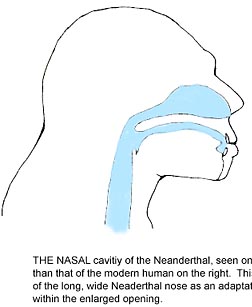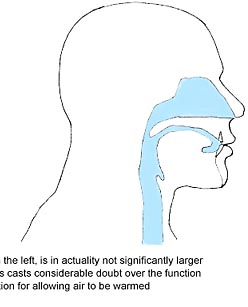NEVERTHELESS, the bite-stress hypothesis gained some support among anthropologists, because it explained the Neandertal face as well as any other hypothesis did. Franciscus's recent research focuses on a crucial but untested assumption of Rak's hypothesis--that Neandertals could bite hard enough to create stresses that would require reinforcement and remodeling of the skull. To determine whether the face might be stressed during biting, Franciscus needed to measure how much force was produced by the muscles that close the jaw, as well as the strength of the bite. But how could he calculate the power of long-decayed muscles when he could only look at old bones?
Fortunately, muscles leave traces on bones that allow anatomists to deduce not only where they joined to the skeleton but also how large they were. These "muscle scars" are small ridges that form on the bone at the point where the muscle attaches. Muscle scars can change size within an individual's life, depending on how vigorously the muscle is used. The more frequent and forceful the muscle's contractions, the more bone is deposited on the muscle scar for reinforcement, and the larger the scar becomes. By looking at the muscle scars on preserved skulls, Franciscus was able to identify the points of attachment for the three muscles that close the jaw and get a good idea of the muscles' size.
Working with Stanford mechanical engineer Carol Kallfelz-Klemish, Franciscus collected data for 31 different skulls. Two were Neandertals (one 40,000 to 50,000 years old, the other about 50,000 years old). Three were "early" modern humans (13,000, 20,000, and 90,000 years old), ancient members of our species. And 26 were "recent" human skulls, all less than 1,500 years old. Twenty of these skulls came from Ohlone Indians, a tribe that not only ate predominantly gritty and tough food, but also used their teeth to soften skins--just like Neandertals.
Franciscus and Kallfelz-Klemish used a digitizer--a machine that gives the three-dimensional coordinates for a particular point--to enter into a computer the size and attachment sites of each muscle. By applying standard engineering formulas to the data, they could then calculate how much force each muscle produced, how much force was placed on the jaw joint, and how much total force went into the bite.
The surprising results, which Franciscus and Kallfelz-Klemish have submitted to the American Journal of Physical Anthropology, undermine the view of Neandertals as particularly hard biters. Although Neandertals could produce larger bite forces than recent humans, they were equaled by one of the early modern humans and surpassed by the 90,000-year-old skull of a Neandertal contemporary. What's more, when Franciscus calculated the efficiency of biting--the bite force divided by the force generated by the muscles--the value was actually lower in Neandertals than in early modern and recent humans.
In other words, for a given amount of muscular contraction, Neandertals actually didn't bite as hard as either the early modern humans or the recent humans. Not what you'd expect if natural selection for biting power were driving the evolution of the face.
To show that this technique gave realistic results, Franciscus compared his estimates for the bite force of recent humans to actual measurements taken on living, biting people. (Scientists had them clamp down on a force-measuring machine.) Since his estimates fall within the range of measured values, he's confident he's on the right track.
FRANCISCUS and
Kallfelz-Klemish concluded that during Neandertal and human evolution,
natural selection was acting not to increase bite force, but to
match it to body size. The robust Neandertals, with their larger
jaw muscles and massive skulls, did bite somewhat harder than recent
humans, such as the Ohlone Indians, and about as hard as the early
modern humans, who were also more robust than recent humans. But
when he and Kallfelz-Klemish adjusted their calculations to account
for the greater size of the Neandertal skull, the Neandertals' bite
force proved no greater than that of the other groups.
Franciscus quickly adds several caveats. Clearly,
it isn't possible to draw definitive conclusions from just two Neandertal
skulls. He plans to extend the analysis by measuring more early
modern human skulls and at least one more Neandertal skull. Ideally,
he'd like to work with many Neandertal skulls, but few fossils are
in good enough shape for this kind of analysis. Even the skulls
he did use weren't complete--some of the bones had been reconstructed
based on other Neandertal skulls. "You have to work with what's
available," says Kallfelz-Klemish, "It makes you be creative."
To bolster his conclusions, Franciscus would also
like to measure the actual Neandertal fossils, which are squirreled
away in museums, instead of the plastic casts he relied on for this
study. Although the casts are made of shrink-resistant plastic and
look remarkably accurate, they may not have captured all of the
subtleties of skull anatomy, he says.
Franciscus and Kallfelz-Klemish hope their work
will encourage anthropologists to use quantitative, rather than
descriptive, methods for testing hypotheses about evolutionary questions.
"The point of the article is that we won't be able to go back to
the kinds of analyses we once did . . . We're hoping it's a landmark
study," says Franciscus.
In a field where almost every interpretation or
assertion provokes controversy, anthropologists agree that Franciscus
and Kallfelz-Klemish have made a significant advance. World-renowned
Neandertal expert Erik Trinkaus, a professor of anthropology at
Washington University in St. Louis, praises the study for its rigor
and creativity. "Other people have done this at a cruder level,"
he says, but Franciscus and Kallfelz-Klemish "have elegantly demonstrated
that high levels of bite force are unrealistic for Neandertals."
Anthropologist Milford Wolpoff of the University of Michigan, who
disputes Trinkaus's views on the Neandertals's fate and relationship
to humans, concurs. "He [Franciscus] has bitten off a good project,"
Wolpoff says. "If we can see what the muscles are doing, it's a
better way of understanding the behavior."
If the extreme facial features of Neandertals
weren't part of an adaptive package to dissipate the forces of biting,
what was their function? An older hypothesis, proposed in the 1960s
by Yale University anthropologist Carleton Coon, sees the Neandertal
face as an adaptation to the cold climates of northern Europe and
Asia. Blood vessels that deliver blood to the brain pass near the
nasal cavity--the chamber behind the nose where inhaled air is warmed
before traveling to the lungs. According to Coon, the Neandertals
needed a large nose and a particularly large nasal cavity to avoid
chilling these blood vessels.
ALTHOUGH
some anthropologists accept this argument, Franciscus doesn't buy
it. For one thing, among modern people who live in cold climates--Northern
Europeans, for instance--long, narrow noses or small, flattened
ones are the rule. These shapes help minimize the loss of heat from
the nose.
Instead, Franciscus thinks the Neandertal face
may represent an adaptation for having large teeth. In the days
before dentures, losing all your teeth would be fatal. This is a
more plausible cause of death than facial breakage, Franciscus says.
Under the stresses Neandertals placed on their teeth, modern humans'
teeth would wear away by the mid-teens. By starting out with bigger
teeth, a Neandertal could live longer. But to have big teeth, they
needed a big jaw to hold them, which also meant a big face.
If Franciscus's explanation proves correct, an
interesting avenue of speculation opens. The Neandertal mouth could
have served yet another function: a sexual advertisement. When big
teeth mean longer life, a broad smile could reveal as much about
a male's prospects as an Armaini suit and cell phone do today. And
the Stone Age equivalent of Brad Pitt's dimpled chin could have
been buck teeth or an overbite. Of course, fossils can't tell us
whether male Neandertals grinned habitually, or even at all, but
we can imagine another kind of experiment . . . .
 BACK
IN the subway, the commuters turn to gawk at the short, well-dressed
figure. Standing amid the grim-faced New Yorkers, the Neandertal
is smiling--a big, toothy leer. BACK
IN the subway, the commuters turn to gawk at the short, well-dressed
figure. Standing amid the grim-faced New Yorkers, the Neandertal
is smiling--a big, toothy leer.
|



 BACK
IN the subway, the commuters turn to gawk at the short, well-dressed
figure. Standing amid the grim-faced New Yorkers, the Neandertal
is smiling--a big, toothy leer.
BACK
IN the subway, the commuters turn to gawk at the short, well-dressed
figure. Standing amid the grim-faced New Yorkers, the Neandertal
is smiling--a big, toothy leer.